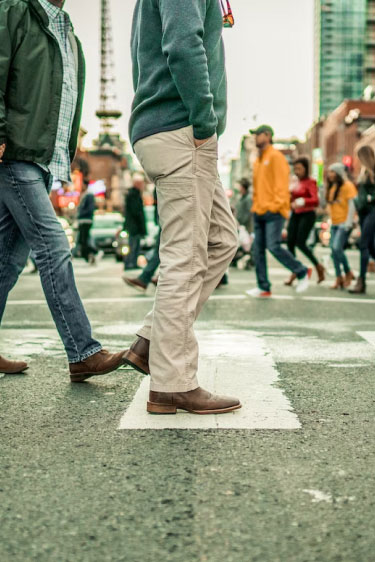Pedestrian Accidents:
A Substantial Threat to Safety
Urban areas are confronted with a pressing issue: pedestrian accidents. These incidents pose a substantial threat to the safety and welfare of individuals who traverse urban environments on foot. With the ongoing rise in vehicular traffic, it becomes increasingly vital to raise public awareness about the perils associated with pedestrian accidents and to explore proactive measures aimed at mitigating them. This article will explore the contributing factors to pedestrian accidents, the repercussions they entail, and practical strategies that can be implemented to give priority to pedestrian safety.

The Causes of Pedestrian Accidents
Pedestrian accidents can arise from various factors, and comprehending these causes is crucial for formulating effective preventive strategies. Here are some common factors behind such accidents:
- Distracted Driving: The prevalence of smartphones and electronic devices has contributed to an increase in distracted driving, leading to pedestrian accidents. Drivers who engage in activities like texting, making phone calls, or using apps while driving become less attentive to their surroundings, making collisions with pedestrians more likely.
- Failure to Yield: Failure to yield to pedestrians at crosswalks or intersections is a significant cause of accidents. This can stem from aggressive driving behavior, lack of knowledge about traffic laws, or simply not paying attention to pedestrians waiting to cross the road.
- Speeding: Driving at excessive speeds significantly reduces a driver’s ability to respond to unexpected situations, increasing the risk of accidents. When drivers exceed speed limits, they have less time to notice pedestrians and bring their vehicles to a stop, leading to severe collisions.
- Impaired Driving: Operating a vehicle under the influence of alcohol or drugs is a dangerous practice that impairs a driver’s judgment, coordination, and reaction time. Intoxicated drivers are more likely to fail to observe pedestrians, endangering both themselves and pedestrians.
Understanding these causes enables us to develop targeted measures to mitigate the risks and promote pedestrian safety.
The Consequences of Pedestrian Accidents
Pedestrian accidents can result in severe injuries or even fatalities. The vulnerability of pedestrians compared to vehicles makes them more susceptible to significant harm. Some of the consequences that victims of pedestrian accidents may face include:
- Physical Injuries: Pedestrians involved in accidents often suffer from broken bones, head trauma, spinal cord injuries, and internal organ damage. These injuries can have long-lasting effects on their quality of life and may require extensive medical treatment and rehabilitation.
- Emotional Trauma: Pedestrian accidents can cause emotional distress for both the victims and witnesses. The trauma experienced by the individuals involved can lead to anxiety, depression, post-traumatic stress disorder (PTSD), and other psychological disorders.
- Financial Burden: The aftermath of a pedestrian accident can impose a significant financial burden on the victim and their family. Medical expenses, lost wages due to inability to work, and ongoing rehabilitation costs can accumulate, causing financial strain.
Preventive Measures to Ensure Pedestrian Safety
Efforts to prevent pedestrian accidents require a combination of public awareness, infrastructure improvements, and responsible behavior from both drivers and pedestrians. Here are some measures that can help enhance pedestrian safety:
Public Education Campaigns
Raising awareness about pedestrian safety through educational campaigns can help individuals understand the risks and learn how to be cautious while walking or driving. These campaigns can be conducted through various mediums, such as TV, radio, online platforms, and community events.
Infrastructure Enhancements
The design and layout of roads and intersections play a crucial role in pedestrian safety. Implementing measures like well-marked crosswalks, traffic calming techniques, speed limit enforcement, and the installation of pedestrian-activated signals can improve safety for both pedestrians and drivers.
Improved Street Lighting
Adequate lighting is essential to enhance visibility for both drivers and pedestrians, particularly during nighttime. Increasing street lighting in areas with high pedestrian traffic can reduce the risk of accidents by ensuring that pedestrians are visible to drivers and vice versa.
Strict Enforcement of Traffic Laws
Law enforcement agencies should enforce traffic laws, especially those related to yielding to pedestrians at crosswalks and intersections. Strict penalties for traffic violations can serve as deterrents and promote responsible driving behavior.
Pedestrian-Friendly Urban Planning
City planners should prioritize the needs of pedestrians when designing urban spaces. This includes creating wider sidewalks, pedestrian-only zones, and dedicated bike lanes, as well as reducing vehicle speed limits in residential areas.
Encouraging Active Transportation
Promoting walking and cycling as viable transportation options can reduce the number of vehicles on the road, ultimately decreasing the risk of pedestrian accidents. Providing safe and convenient infrastructure for pedestrians and cyclists, such as bike lanes and pedestrian pathways, can encourage people to choose active transportation methods.
Technology Solutions
Advancements in technology can also contribute to pedestrian safety. For instance, the implementation of intelligent traffic systems that use sensors and cameras can detect pedestrians and automatically adjust traffic signals to ensure safe crossing opportunities.
Community Engagement
Engaging the community in pedestrian safety initiatives can create a sense of ownership and responsibility. Local organizations, schools, and businesses can collaborate to organize pedestrian safety workshops, events, and awareness campaigns to educate and empower individuals to make safer choices.
Awareness Against Pedestrian Accidents
The issue of pedestrian accidents necessitates the attention and involvement of multiple parties. It is crucial to comprehend the reasons behind these accidents and their outcomes in order to establish proactive measures that enhance pedestrian safety. By combining efforts in public education, infrastructure enhancements, and responsible conduct, we can actively promote the welfare of pedestrians and foster communities and cities that prioritize their well-being. Whether you are a driver or a pedestrian, exercising caution, adhering to traffic regulations, and maintaining awareness of your surroundings are invaluable practices that significantly contribute to preventing pedestrian accidents and cultivating safer streets for everyone.
